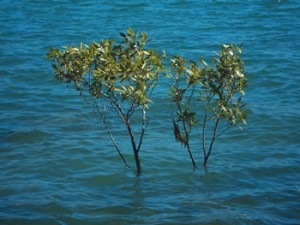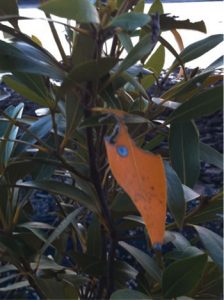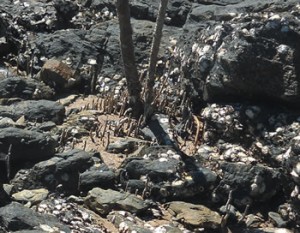The Parable of the Mangrove (2)
“Now there are two”
by Phil Cody sm
You may recall (Marist Messenger May 2011) a reflection on ‘The Parable of the Mangrove’? It outlined some life-lessons I learnt while on retreat near Rockhampton where I met up with a solitary mangrove in the sea. This year, I was fortunate enough to return there. You can imagine my anxiety to see if the mangrove was still there after two years. It was dark when I arrived, so I had to wait till the next day to go down to the beach and find out. Waiting was my first lesson.
At first, I couldn’t see anything next morning, so was resigning myself to the fact that some storm had destroyed the mangrove. Then, there it was. Yes, still there - and ‘now there were two’!! The brave mangrove had survived for two years and was quietly there with its proud head above the sea, looking green and well. I calculated there had been about 1460 tides since I had last been there! The mangrove had survived all sorts of pulling and pushing of the sea and maybe some close encounters with a hungry turtle.
So I wondered about ‘survival’ and how, sometimes in life, with all its ‘pushing and pulling’, the main thing is to quietly survive and sustain oneself. The mangrove had obviously had some challenges – I carefully removed bits of nylon and plastic that were stuck in its branches and some weeds that seemed to be choking it. I wondered what aspects of my life needed ‘careful removal’ and which maybe I had sort of grown used to having stuck on me.
The mangrove had in fact some dead branches and I pruned them off. I thought of St John’s Gospel (15:2) He cuts off every branch in me that bears no fruit, while every branch that does bear fruit he prunes so that it will be even more fruitful. Sometimes I need some aspects of my life pruned away as it is a waste of energy trying to pour life into what is not fruitful.
Another thing that somewhat surprised me, was that the mangrove did not seem to have grown a lot. Sure there were now two main branches, both with healthy leaves, but it was still relatively small. I wondered if that had a lesson for me. It is not necessarily in big achievements that I am successful. There may not be large growth in my life or qualities. In fact it is often sustaining ‘smaller’ patterns of relationship or achievement that is more important. Faithfully completing the daily routine, yes, even down to emptying the dishwasher or getting the lunches ready, are the real proof of love sustained. I need to constantly re-learn to ‘pace myself’ and cherish the value in doing small things well. What comes to mind is the story of the contemplative who was taking his turn sweeping the corridor. When asked what he would do if he was told that he would die within the hour, he replied, “I would carry on sweeping the corridor”!
The two branches sharing together made me think, too. Two is better than one. While I need space on my own to reflect – it was what I was doing on retreat - in general I need to share and have company. While that often brings tension and difficulty in handling conflict or sorting through some things, that is what life is about, not just me living a cosy, solitary life. There is often a symbol of this in nature. Flax bushes need to have other flax around them to grow strong. Some trees actually die or get blown over if they lack the shelter and support of some ‘mates’ or ‘companions’. So I might think I can survive on my own, but, for example, not having the couple I go to spiritual direction to for 5 months while they were overseas, made it clear to me that I need someone to share deeply and journey with.
The mangrove, now two, echoed a Maori proverb ‘Awhi mai, awhi atu, tatou, tatou e’. ‘You support me, I will support you and we will grow strong together’.
 The mangrove had one or two yellow leaves and certainly ones with spots or leaves that had been eaten by some bugs. I am not sure if there is a saying ‘beauty with spots on’? Or like the NZ Symphony Orchestra, a ‘beauty spot’. Did you ever do that exercise where you and a class or group went to collect a leaf that ‘spoke’ to you? We had to bring them back and describe why they were special to us. Most often it was the differences that were the telling point, even some scar or spot. Yes, beauty and being special, even down to the spots!
The mangrove had one or two yellow leaves and certainly ones with spots or leaves that had been eaten by some bugs. I am not sure if there is a saying ‘beauty with spots on’? Or like the NZ Symphony Orchestra, a ‘beauty spot’. Did you ever do that exercise where you and a class or group went to collect a leaf that ‘spoke’ to you? We had to bring them back and describe why they were special to us. Most often it was the differences that were the telling point, even some scar or spot. Yes, beauty and being special, even down to the spots!
While the mangrove had not grown a lot, its root system certainly had spread and strengthened. It now spread a longer way among the rock floor, finding sources of sand and nurture from the incoming tides. I was made to think about that when I was sharing with a niece recently about the people I help. She asked me “Where do you get your nurture from?” Good question. It is no use my helping everyone else if I do not take time and make the effort to sustain good ‘roots’ or nurturing relationships with God and others. For myself that is often simply visiting or having a meal with family and friends. I think of one couple, now grandparents, where there is an open invitation to come for a meal – ‘just give us a ring’. Even when we may all be tired after a full day, we enjoy some good sharing and get energy and renewed purpose for the next ‘tide’.
A very good reminder of that for me is children. There are one or two who have that genuine affection and challenge that can literally stop me in my tracks! I recall I was at the start of a fairly large ceremony which I was conducting and I was a little on edge. Two children from a family I visit came up and gave me a big hug (admittedly it was at knee level!), but it was a lovely way to remind me that I was loved and was challenged to love in turn. I think the mangrove must sense that from time to time as the sun shines and the breeze cools her.
A theme that made itself present in the retreat was to ‘befriend’ what is happening in my life. Just as the mangrove had ‘befriended’ the snails, the flies, the limpets, the molluscs and other animals and things that had found a second home on the mangrove, so I was invited to befriend the various aspects affecting my life. My first reaction when I am criticised or someone does something that annoys me is to react, to defend or to ‘attack’. The wiser move is to become more aware of what is happening inside me, to really feel and recognize the anger or hurt, to ‘own’ it, and then ‘befriend’ it. It strangely loses its power over me and I can much more healthily respond to the person or situation. A wonderful way to do this is the simple comment ‘So you are saying…. you are feeling….’ I think that factual ‘befriending’ had helped the mangrove survive and live more peacefully. A time I need to check this is in my evening examen of conscience before going to bed. ‘How did the day go? What were occasions that I did or did not befriend what was happening? What might I learn from that?’
Well it soon became time to farewell my friend the mangrove once more. I was reminded of going with a mother to take her 4 year old Ezekiel to day care. We had handed over his lunch and jacket and he lined up with his tiny-tot class to march into the classroom. Ezekiel gave us a rather shy wave as he walked past and I was very moved by that. It was similar tothe mangrove, and maybe quite a few of our farewells in life. “Bye for now. I have to get on with some other aspects of life. I look forward to meeting again, if that is meant to be. I am proud of you’.
A tona wa, dear mangrove.

 Entries(RSS)
Entries(RSS)